- Farrell Monaco explains Fornacalia and how to make Bread for the Gods.
- Rothamstead Research says Scientists prove high fibre white loaf is possible. Yeah, but why? And when?
- You can judge a book’s market by its cover.
- Simple explanations for why (some of) our forebears cooked Jell-O bejewelled Spam salad.
- This Twitter thread takes that thought to new and unpalatable extremes. (If you’re not on Twitter, here’s an alternative version but it isn’t nearly as much fun to look at.)
- Food fraud through the ages examined by Alex Danco; only the modalities have changed.
Coffee culture in Italy and England A shave and a cappuccino
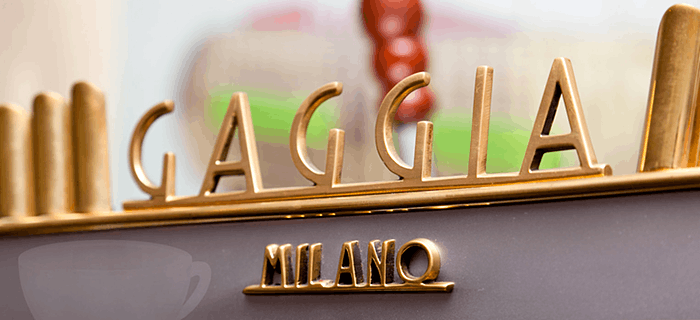
Podcast: Play in new window | Download (Duration: 29:15 — 23.5MB)
Subscribe: Google Podcasts | Spotify | Android | RSS | More
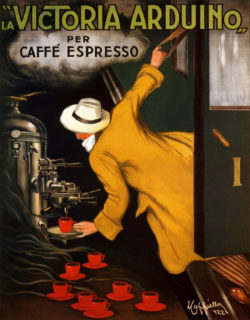
The original espresso coffee, at least as a widely available beverage, goes back only to the earliest years of the 20th century. That’s when Luigi Bezzera, a Milanese inventor, got his first patent on the machine that became the Pavoni Ideale in 1905. But while it was touted as an espresso machine, making coffee expressly for you at express train speed, we would not recognise the cup it offered as a modern espresso. Jonathan Morris, professor of history at the University of Hertfordshire in the UK, describes it as slightly more concentrated filter coffee. The first modern version of the espresso, in 1947, wasn’t even called that. It was a caffè crema, for the creamy emulsion on top, which distinguished it from all previous coffees.
Jonathan Morris and I talked about the growth of modern Italian coffee culture, taking in the fascists’ horror of inessential, un-Italian luxury goods and the transformation of the society from rural and agricultural to urban and manufacturing. More than that, though, the theatricality of the espresso machine helped to launch the London coffee bar which, even if the coffee was nothing like the Italian original, nevertheless drove the rise of the teenager and pop music.
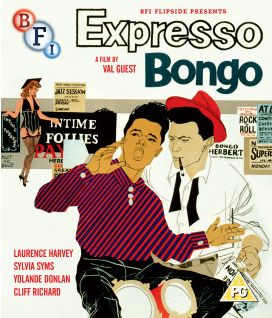
Notes
- Jonathan Morris’ Coffee: a Global History is available from Reaktion Books. Enter “coffee20” at checkout to get a discount.
- Expresso Bongo — “probably the best rock’n’roll movie made in England prior to A Hard Day’s Night” — can be bought from the British Film Institute, with lots of additional material.
- There’s a fair bit online about the 2I’s coffee bar in London, not the first, but perhaps the most influential, certainly as far as music goes. I enjoyed this history.
- Poster for La Victoria Arduino’s espresso by Leonetto Cappiello. Banner photo by Mark on Flickr.
What to do with unwanted offspring
How about deep-fried chick on a stick?
France to ban culling of unwanted male chicks by end of 2021 BBC news told us yesterday, and I could barely contain my disbelief. Unwanted males are the price you pay for specialised breeds, whether dairy cows or layer hens.
Eat This Newsletter 116 Eat well to do good
- Pro-meat, anti-pro-meat, pro-anti-meat — everybody’s got ties to industry.
- How Did Humans Boil Water Before the Invention of Pots?
- How New York’s Bagel Union Took on the Mob (and, incidentally, ruined bagels).
- Börek has an even longer history than bagels.
- Nature Food launches. I pick at A national approach for transformation of the UK food system and The Londoner’s meal.
- Frieda Kaplan, the Kiwi Queen, died a couple of weeks ago.
- Terrific story on the background of the biggest “organic” scam in American history.
- Obama, source of salted raw mackerel and other delicacies.
- Now that you’ve appropriated kimchee, maybe it is time to do the same for kimjang?
Subscribe for my additional commentary. You know you want to.
Why a spurtle makes a superior porridge stirrer It's the shear stress, stupid

Podcast: Play in new window | Download (Duration: 9:39 — 7.9MB)
Subscribe: Google Podcasts | Spotify | Android | RSS | More
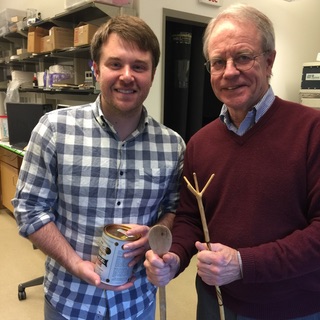
Here, for the New Year, is a confession and apology.
I was completely wrong about porridge-stirring implements and I am here to make things right.
In the episode about Porridge, I mocked the idea that the traditional Scottish spurtle, which to all intents and purposes is just a stick, might be better for stirring than a spoon. My (faulty) reasoning was that a spoon offered a greater surface area to break up lumps. In fact, as I now know, the stirrer does not break up the lumps directly.
I noted in Eat This Newsletter 110 that a friend of a friend, who is a specialist in fluid dynamics, said that he had “a working, testable hypothesis”, which required only some worthy porridge in order to test it. So, I packed a bag of my favourite oats ready to meet up at Georgetown University in Washington DC.
I should explain that Dr David A. Gagnon, the physicist in question, is the son-in-law of one of my dearest friends, who happened to be visiting when I was editing the episode. That was how David came to know of my puzzlement – and he has access to wonderful machines that can make very accurate rheological measurements. Rheology is the study of flow, and David’s idea was that the faster the stirrer moved through the porridge, the lower the viscosity of the porridge would be. Shear stress in a material like porridge would be greater at higher flow speeds, and it is the shear stress that gets rid of lumps.
You can think of shear stress as being a difference in the speed of flow of the liquid across a small distance, multiplied by its resistance to flow. That resistance to flow is what we think of as viscosity. In a viscous liquid, like honey, the stirrer produces a lot more shear stress than it would moving through water at the same speed. But there’s a crucial difference between honey and water.
In water, the viscosity is the same no matter how fast the stirrer moves. Honey is different; the viscosity decreases the faster the stirrer moves. And that means that the stirrer produces more shear stress when it is moving quickly through the honey than when it is moving more slowly. David’s idea was that fast stirring would result in lower viscosity, and lower viscosity would result in greater shear stress.
To get back to porridge, and to lumps, consider a lump as the stirrer moves past it. Relatively speaking, the part of the lump in the slower flow near the edge of the stirrer is being held fast, while the part in the faster flow is being pulled away, and that’s what destroys the lump, pulling it apart.
The rheometer measures all that. It has two circular plates, one above the other, and the bottom plate can be rotated very accurately through a known distance at a known speed. David carefully loaded a little bit of porridge onto the bottom plate and then lowered the top plate to make contact with the porridge. The layer of porridge mechanically connects the bottom plate to the top plate, which in turn is connected to sensors that accurately measure how fast and how far it rotates. Meanwhile, David had programmed the machine to oscillate the bottom plate over a wide range of frequencies. The faster the oscillation, the greater the stress on the porridge. The machine then takes all those measurements and creates a set of graphs that describe the rheological properties of the porridge.
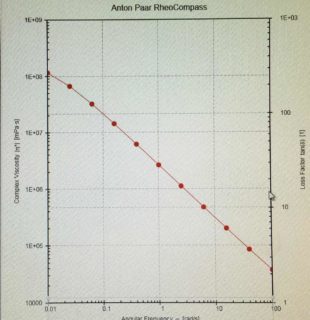
The graph appeared and I confess it was really exciting to watch the points appear. A straight line down from top left to bottom right over a huge range of stirring speeds. As David had suspected, the viscosity declines linearly with the speed of rotation.
Like good experimentalists, we turned to a nearby, very heavily used whiteboard to try and get a grip on what was happening.
David drew a circle, a cross section through the spurtle, and an elongated ellipse, a cross section through a spoon, and flow lines as they moved through the porridge. For any given speed of movement, the energy needed to move the spurtle would be lower than the energy needed to move the spoon. Likewise, for any given amount of energy, the spurtle would move faster than the spoon. Shear stress depends on speed of movement. So, with a spurtle, it takes less energy to get a certain amount of shear stress and thus a certain amount of lump-disruption.
But there’s more. Because the viscosity of porridge goes down as you stir faster, the rapidly-moving spurtle is even better at breaking up lumps than the slower-moving spoon.
And that is why a spurtle is better for stirring porridge. It’s more efficient.
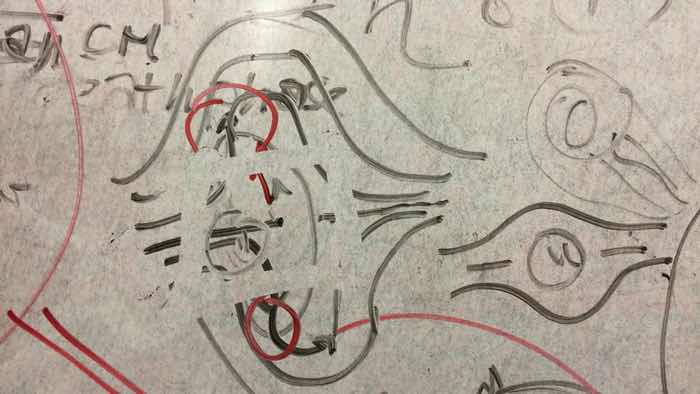
Conceptually, my real breakthrough moment came as David was drawing the flow lines. There is a dead area, just in front of the spurtle and the spoon, where the porridge is not flowing past the stirrer. The dead area impedes the forward movement of the stirrer, and is considerably bigger for the spoon. However, if you remove the large blade of the spoon, you’re left with a spurtle.
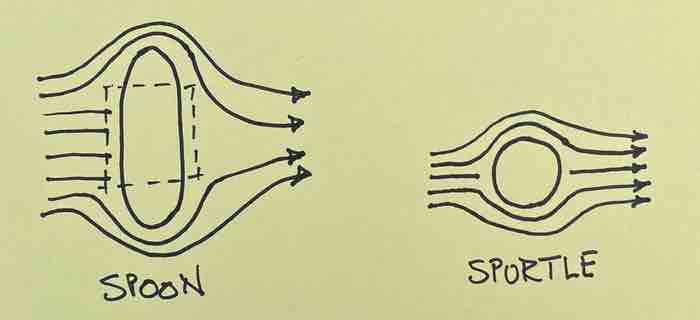
Some additional thoughts:
- My friend Robert, David’s father-in-law, brought with him an Ethiopian stirring stick, with four mini-spurtles emerging from the main cylinder. You can see it in the photograph. Very, very effective, as they must have discovered long before rheometers.
- A spoon with a hole in it, or even one with slots in it, would also be very effective at destroying lumps.
- Maybe the reason a balloon whisk is extremely good at dispersing lumps in, say, a white sauce, is that it consists of a large number of spurtles, each one creating shear stresses in its wake.
- And finally, David pointed out the most efficient method of all might be to stir porridge with a spoon or paddle keeping the blade parallel to the wall of the saucepan, because the long surface would result in a larger area of shear stress. Most efficient, perhaps, but way too difficult.
My overall conclusion: if you have a spurtle, use it. If you don’t, don’t worry about it too much.
Huge thanks to David Gagnon and Robert Seyfarth for making this bit of experimental fun possible. And of course, any errors in this account are mine and mine alone.
Notes
- Shear-thinning is the technical term for no-Newtonian fluids like porridge, honey and modern, non-drip paints. Shear-thickening is much less common, and much more entertaining. (Blue Peter never used to be this much fun.)